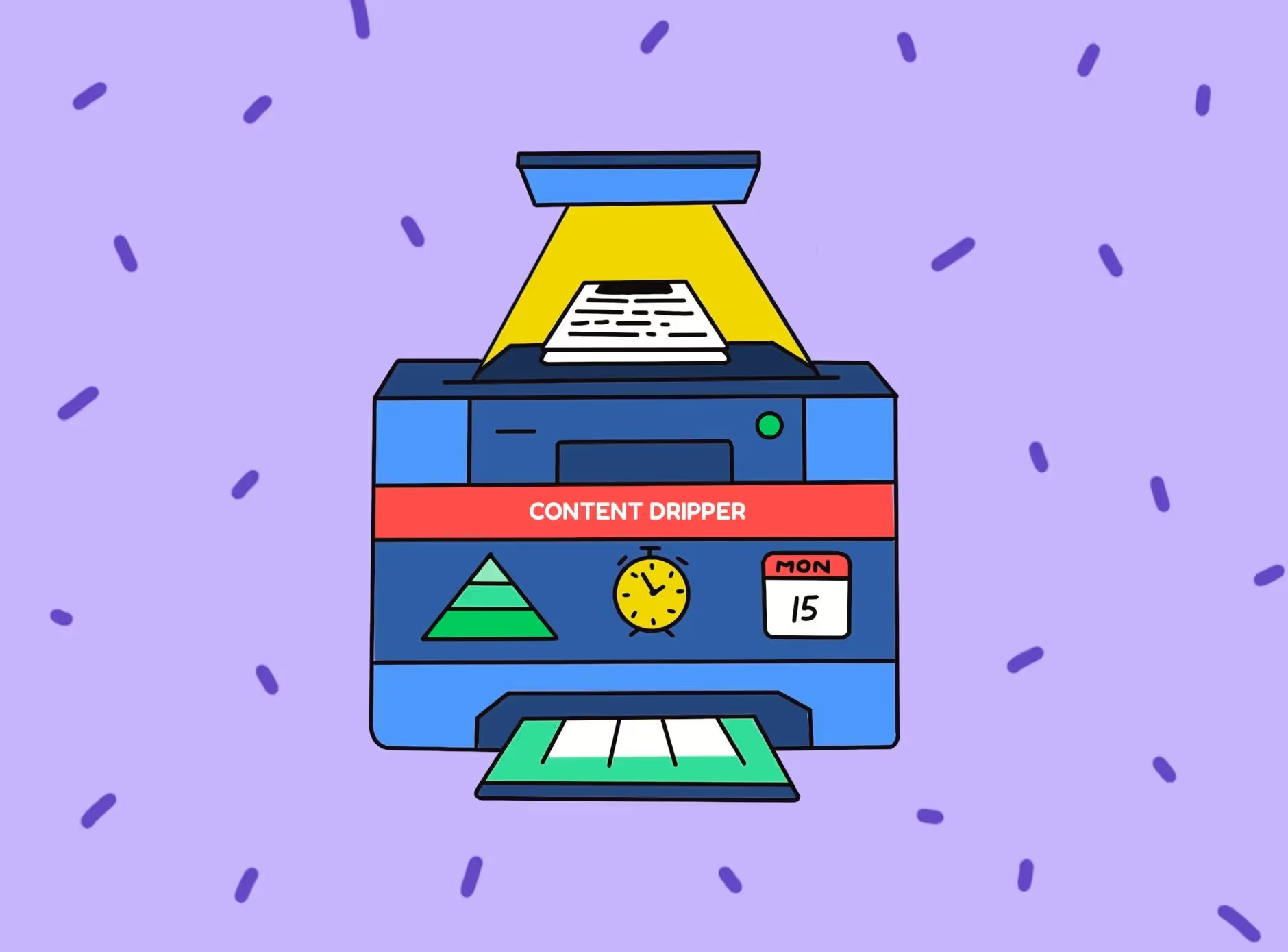


Key Takeaways
You can take a free course at any time. You don’t have to wait for the next term, fill out an application, or be admitted. And you can study it at your own pace, whether that’s one hour a day or five minutes between meetings. But just because it’s easy for students to take your course at any time doesn’t mean they will. Once you’ve launched it, the challenge is getting people to sign up and start learning from it. That’s where drip content comes in.
Drip content is delivered regularly rather than all at once. It’s how Netflix gets subscribers to binge-watch entire seasons of shows in one weekend and how blogs get readers to await new posts every week eagerly. When I think of the future, I don’t imagine a world where people stop learning new skills. I believe the opposite is accurate, and we’re going to see an even greater emphasis on continuous learning as people need to keep up with the changing market.
But what does this mean for you?
As an online course creator, you have an opportunity to get ahead of the curve and begin using drip content marketing strategies to your advantage. When you’re building an online course, it’s essential to get your audience excited about the content you’re providing,
But how do you do that?
In today’s post, I will walk through exactly what drip content is and how it can be used to build a community of excited students ready to learn from you. When you finish reading this article, you’ll have everything you need to create a drip content strategy for your online course business. Let’s get started!
What Exactly is Drip Content Strategy?
An article, blog post, or video is released one at a time.
At the beginning of the internet, we were all so used to content being delivered in a linear format — the way it was on TV. You had to wait for your favourite show to come on at night, and if you didn’t catch it then, you’d have to wait until it reruns. With YouTube, Netflix, Hulu and other platforms, we’ve grown accustomed to binge-watching. But with drip content, we can enjoy both formats. Drip content allows us to release our work in a more structured way that helps us build anticipation for what’s next and keeps our audience engaged over a more extended period.
There are many different ways to use drip content for marketing:
- Video series: With YouTube or Vimeo, you can create multiple videos that tell one big story (i.e. the Hero’s Journey).
- Email series: With MailChimp or Drip, you can set up an email campaign that will send emails one after another for a specific amount of time (i.e. five emails sent out in 5 days).
- Audio series: With Soundcloud, you can release multiple audio clips (or podcast episodes) spread out over a specific period (i.e. five episodes released over five weeks).
- Blog posts: If you’re writing a blog post and want to spread it out over more than one post but still have it all be part of a bigger story, you could use the “Read more” tag to break up your content into different pieces.
- Paid membership sites: Like social media campaigns, paid membership sites like Lynda.com provide their subscribers with drip content regularly, so they don’t get bored with their offerings.
- Ebook/workbook series: With Leanpub, you can release chapters of an ebook or workbook one after another for a set time. You can even get your audience to pay for the content upfront before it is released!
Of course, if you find a universal platform that drips all sorts of content, it would save you a lot of time.
6 Business Models for Producing and Selling Content
As a membership site operator, you are faced with several business models from which to choose. For instance, you can do the following:
- All-access - You give complete access to all of your content for free and then make money through advertising or sponsorships.
- Time frame - You release your content in batches over time, like a course or series of books, and you charge a fee for each set.
- Online courses - You create an online course that teaches students one-on-one or in small groups through video conferencing, screen sharing, etc. You charge a fee for each student who wants to enrol.
- Online community - You create an online community where members have access to exclusive content and other benefits (like discussion forums or special events), and you charge a fee for membership.
- Product-based - You create an information product that you sell to your audience (like a book, workbook, audio program, video program, etc.), and you make money from the sale of each product.
- Productized services - You productize your services to offer them at scale (like by creating packages or templates), and you make money from the sale of each service.
You may be wondering why you should use drip content?
Online course creators use drip content, a content delivery method that gradually releases learning material over time, to:
Engage Students
Encourage students to engage with your course and connect with your other students by releasing your course’s content every week.
This way, students will receive consistent reminders about your course. Students will be less likely to forget about your course or drop out by coming back each week for new content.
Protect Your Intellectual Property
Prevent students from printing off or copying all course content at once by releasing it slowly over time.
You can also limit access to each module by setting deadlines for when students are allowed to view the next module.
Improve Student Retention
Help students learn more effectively and retain what they’ve learned by spacing out lessons over an extended period.
This way, students have more time to process and review the information you present in each lesson. If you release all your lessons at once, they may feel overwhelmed and abandon the course because they don’t know where to start.
Save Time
Only spend a few hours creating and editing one module at a time instead of spending weeks working on all the modules of your entire online course before launching it.
When you publish just one module at a time, you can take the pressure off yourself to create the entire course before you launch. And your students will be satisfied with the content they have access to while they wait for new modules.
Avoid Information Overload
If you release all of your online course content at once, your students may get overwhelmed and choose not to go through all of it.
On the other hand, if you drip out the content over time, they won’t feel stressed out by having too much information in front of them at once. Plus, when students can focus on one module at a time, they’re more likely to retain the information from each one.
What’s the Best Way to Deliver Drip Content?
To deliver drip content, you need to know what each user should see next and where you should send them. The first question is more accessible to solve than the second. You can answer it with a smart growth strategy that provides the proper steps for each user based on their current state.
The second question, however, requires a bit more work. Platforms like Facebook Messenger, where users initiate conversations with your bot, are straightforward because they already have a natural entry point. But email is much more challenging because there’s no standardized way of entering into a user’s inbox flow. If you’re sending a series of emails to your new customers, how do you write them so that people read them? The best way is to make each one feel like a complete piece of content—a message with one idea that does one thing.
If you send a chain of emails about your product, for example, make each email about one feature of your product. “Here’s how X works”, or “Here’s why we designed Y as we did”, or “Here’s what makes Z different from everyone else.” The trick is to make each email something the user can consume in less than 2 minutes because 2 minutes is the most time they’ll have when they’re reading their email.
Keep this up, and those 2-minute messages will teach the user something important about what you do and why you do it over time.
How To Deliver Online Courses as Drip Content?
I want to warn you that you need to be very careful because there is a fine line between delivering your course as drip content and not delivering it.
I don’t mean that the difference is subtle or hard to understand.
It’s pretty apparent that either you deliver your course or don’t. If people are paying for your course and are not getting what they paid for (the actual course), you have a problem. Therefore, if you decide that you want to deliver your course as drip content, make sure that it’s clear from the beginning (on your sales page) that the course will be delivered over time and the exact schedule of its delivery. If you deliver the course over an extended period (for example, once a week), make sure to release at least one lesson every week. And if there is any chance whatsoever that you might not release a lesson at some point (for example, due to illness), then make sure that it’s evident in advance what would happen in such a situation.
If students can only obtain new lesson content by attending some live event (for example, a Skype call or webinar), make sure that it’s evident in advance what would happen if you were unable to attend. One of the things that I have been asked about lately is how to deliver online courses as drip content. It’s a good question because it’s essential to think about how you will release your content before you start creating it.
If you’re not careful about how you release your content, then there is a good chance that you will lose momentum and never get to the end of the course.
Here are some tips that I have found helpful in making sure that this doesn’t happen:
- Make sure to release at least one lesson every week
- If there is any chance that you might not release a lesson at some point (for example, due to illness), make sure that it’s evident in advance what would happen in such a situation.
- Make sure that it’s clear how long the course will take (a good rule of thumb is three months)
- Make sure that there are no gaps between lessons (for example, if you are going to deliver the course over an extended period (for example, once a week), make sure to release at least one lesson every week)
Different Types of Drip Content
Drip campaigns have evolved. Some have a fixed date, and others are triggered based on activity or user behaviour.
Fixed date drips rely on specific dates, such as birthdays and anniversaries. In contrast, activity-based drips are triggered by users’ particular actions, such as clicking on a link or buying a product. Issue-based drip campaigns are those where you specify the subject line, name, message and other variables for each email in the series.
Let’s look into all the different types of drip content and see what fits you best:
Evergreen Drips
One of the most common types of drip content is evergreen content. This is an easy way to stay in touch with your audience without writing individual emails from scratch each month. Evergreen content is similar to a resource library. A subscriber gets access to all of your evergreen content immediately after subscribing and continually gets new content added throughout the lifetime of their subscription.
This type of drip content is excellent for popular topics with ongoing interest. This could be something particular like “the best tools for remote workers” or something more general like “how to get more referral traffic.” These can be newsletters, tips and tricks, or any other type of content you want to send regularly. This type of drip content is always accessible from your resource library or somewhere else on your site (like a blog).
You don’t want to limit your readers’ access once they’ve subscribed and paid for the product. This also means you’ll want to create a lot of this type of content upfront so that subscribers can get immediate access when they sign up.
Fixed Date Drips
Fixed date drips have a set start and end date. This is good for seasonal content that only needs to run during a specific period each year.
For example, if you sell Christmas decorations, you might want to send a series of emails in December reminding your customers to pick up some ornaments before they’re gone until next year. You could also use fixed date drips to announce a new product line as part of your launch strategy and stop sending once the launch has completed. Lesson Drips strategy is an example of a fixed date drip.
In a lesson drip, each new lesson in the course is released on a specific date. If a student enrols in your course on day one and includes three lessons, then the first lesson would be immediately available. The second lesson would be available one week from now, and the third lesson would be available two weeks from now.
Module Drips
A module drip works very similarly to a lesson drip. However, each new module is released on selected dates instead of releasing each new lesson on specified dates. You have three modules in your course: Module 1, Module 2, and Module 3. Each module includes two lessons (for example, Lesson 1A and Lesson 1B are included in Module 1). If a student enrols in your course on day one and you set up your course to release modules on specific dates, then both lessons in Module 1 would be immediately available to that student. One week later, both lessons in Module 2 would become available to them.
There are many types of drip sequences with different goals and results. A few examples:
Activity-Based Drips
These are emails sent when someone takes action on your website or your app. An example of this would be a ‘Welcome’ email that sends immediately after someone signs up for a free trial.
Time-Based Drips
These are emails sent after a specific period, like 15 days or one month. They are often combined with activity-based drips (see the next point).
Event-Based Drips
These email campaigns trigger when a user completes a specific event within your product, such as reaching a particular milestone or level or completing a tutorial. They can also be used as part of an onboarding sequence to encourage users to set up their accounts or profiles.
Content Drip Campaigns
These are usually triggered when someone subscribes to your blog via RSS feed or email (see the next point).
Recurring Emails
Recurring emails are sent at intervals (for example, every Monday morning) and share content like new blog posts or how-to articles that keep people engaged with your brand long-term.
Conclusion
If you want your students to feel like they’ve gotten their money’s worth and continue engaging with your course content, drip content is the way. If you’re wondering how to begin building a customized drip content strategy for your course, first, you need to do some brainstorming. Write down all of the things you want to teach your students and any extra resources that might be helpful to them. Then prioritize this list based on what will be most beneficial for them in the early stages of the course.
When you have that finalized, start identifying which points would make suitable candidates for drip content, primarily in which topics would provide immediate value in supporting their learning objectives. Break these big ideas down into digestible chunks and create plans for incorporating them into your drip content schedule.
The point of drip content is to educate and engage your audience continually. This can help you build a long-term relationship with your students and increase their chances of completing your course.
Recommended Reads
Recommended Reads












.png)
.webp)
